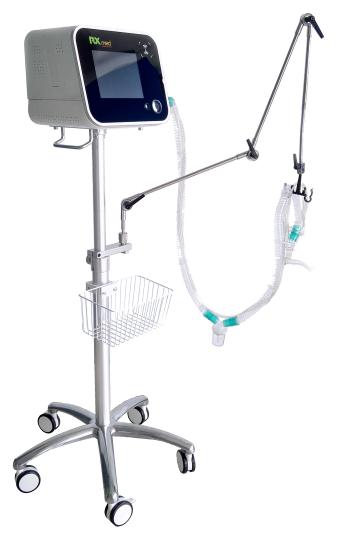Source: administrator
Once patients with COVID-19 develop severe pneumonia, noninvasive mechanical ventilation is required, and in more severe cases, invasive mechanical ventilation is required. Lung inflammation in patients with severe pneumonia is often diffuse, and sputum and exudate caused by inflammation are constantly produced not only in the proximal part of the main airway, but also in the distal part of the lung. For these patients with invasive mechanical ventilation, the current standard of ICU airway nursing in any country is manual catheter suction, including open and close catheter suction, as well as fiberoptic bronchoscope suction.
This manual catheter suction is a problematic golden standard of ICU airway nursing. Firstly, it affects the normal functioning of a ventilator, and can only clear the secretions in the main airway of right lung, cannot suck secretions of the left lung and in small airways under level-two, thus remaining secretions unremovable in deep lung, which is very adverse for curing pneumonia. Secondly, catheter suction causes a great hemodynamic impact on the patient, resulting in airway bleeding, scarring and other complications, and painful feelings. The catheter repeatedly enters and exits, easily bringing pathogenic bacteria into the deep lung, leading to ventilator related pneumonia and affecting the treatment effect and prognosis. Thirdly, due to catheter suction cannot remove small airway sputum, the open fiberoptic bronchoscope suction is adopted, causing a very high risk of virus infection towards the medical staff. Finally, the medical resources, especially human resources, occupied by such a large number of ICU COVID-19 patients are huge.
CoughSync in-line exsufflator provided by Ruxin Medical is very suitable for the airway cleaning of critical pneumonia patients who need invasive mechanical ventilation, replacing most of the catheter suctions to be adopted, which is highly targeted to solve the various disadvantages of catheter suction. First, the suction process does not need to disconnect the ventilator to ensure the safety of patients’ ventilation. Second, with such a non-invasive suction, there is no damage to the airway of the patient. At the same time, the suction is carried out under closed conditions, thus no more introduction of bacteria leading to accidental infection. Third, like natural cough does, cough simulation can remove the secretion in the main airway of left and right lung at the same time, and promote inflammatory secretions in distal small airways. The efficacy is more effective than any product currently available on the market. Fourth, CoughSync can be set to work automatically after the sputum cleaning process does not require the intervention of nurses, nurses only need to inspect and ensure good ventilation and humidification, thus greatly reducing the working intensity of medical staff and the risk of infection. For the treatment and nursing of severe pneumonia patients in ICU who currently occupy a large amount of medical resources, in-line cough simulation of CoughSync can be atimely and uniquely valuable solution.
On February 18, Chinese medical experts began releasing autopsy reports on departed COVID-19 patients. According to the autopsy results, the lung status of the COVID-19 patient was a little different from that of SARS. There was no severe fibrosis, the alveoli were still present, but the inflammation was severe, and the lung contained a large amount of mucus, which caused the patient's ventilation was not smooth. Clinically, patients with covid-19 in critical condition showed little secretions sucked out, but in fact, a large amount of mucus was retained in the lung and could not be cleared, leading to airway obstruction. This should be an important reason for patients with insufficient ventilation, low blood oxygen saturation and difficulty in saturation promotion, resulting in hypoxemia and multiple organ failure.
Obviously, in order to solve the problem of secretion retention in bronchi, the current methods, such as catheter suction and fiberoptic bronchoscope suction, have become ineffective. And the other techniques of airway cleaning left in ICU are common vibrators (which only provides external vibration but cannot drain secretions), non-invasive exsufflation machine and In-Line Exsufflator like CoughSync.
Only CoughSync can achieve: on the one hand, without interfering with the normal work of the ventilator, to maintain the patient's ventilation and oxygenation; on the other hand, to simulate natural coughs by using the expiratory phase of the ventilator, mobilizing secretions of left and right lungs gradually from small bronchi up to the main airway by taking advantage of high-speed airflow, and then removing them gradually out of the artificial airway. This result usually requires CoughSync to work with the ventilator simultaneously for more than four or five hours. Therefore, the earlier the invasively ventilated patients to be put on CoughSync, the better the patient's lungs to be cleared, and the sooner inflammatory secretions thus to be removed (rather than waiting for secretions to accumulate until to block some small airways, then start cough simulation). In that way, not only can effectively clear airway, obviously improve and maintain good oxygenation, but also can cure pneumonia as soon as possible. This approach is consistent with the emphasis in the diagnosis and treatment of this epidemic in China on moving forward the treatment threshold, such as taking invasive mechanical ventilation in advance for critically ill ICU patients to buy time for treatment.

To sum up, the value of the CoughSync provided by Ruxin Medical for fighting covid-19 is at least as follows: 1) Minimize the number of times of manual suction to reduce the risk of complications caused by airway trauma due to manual suction, and reduce patients' pain of secretion removal. By which the invasive ventilation time of the patient is expected to be shorten, thus more efficient treatment could be achievable. It can also relieve the current tension situation of intensive careunit (ICU) resources, especially the shortage of ICU ventilator. 2) Reducing the workload of airway care for ICU staff while reducing their risk of infection; 3) The only physical method promising to solve the problem of secretion clearance in the deep lung of critically ill COVID-19 patients.